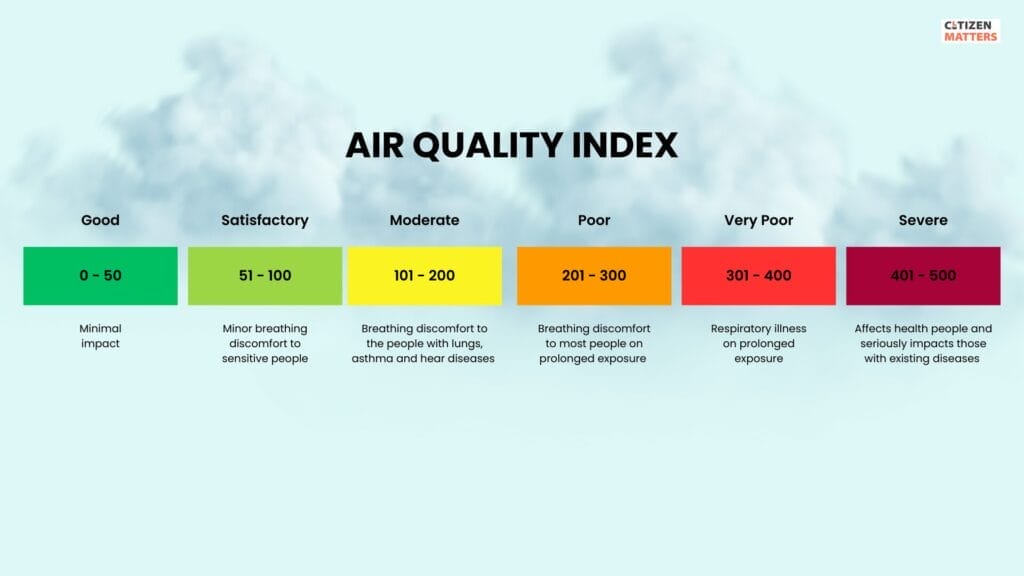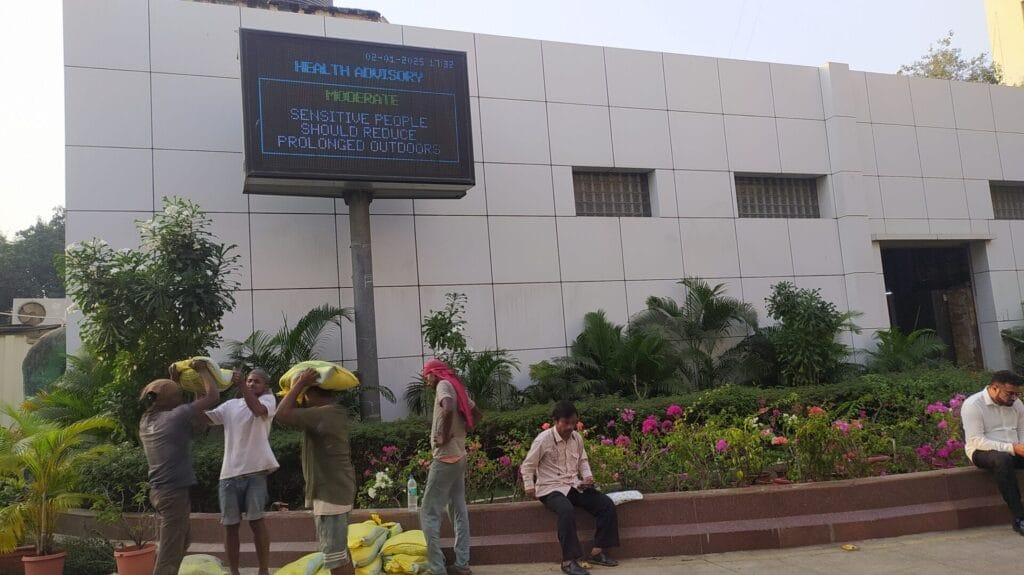Mumbai may not yet be Delhi but it doesn’t mean that the air we breathe in the city is healthy. Though Delhi stands out among the most polluted cities during winters with its smog and alarming levels of AQI, the toxicity of Mumbai air is considered to be higher, according to this report from The Times of India. This is because of the increasing concentration of PM2.5 from automobiles, industries, construction activities and garbage burning, all of which affect air quality.
Read more: Mumbai’s air pollution: Smog chal raha hai
Mumbai’s proximity to the sea is no longer a guarantee that the polluted air will not hang heavy over the city skies. Activists feel that the air quality situation in Mumbai should now be treated as an emergency, and there has to be more transparency about the situation overall. Citizens and policy makers both need more data, real time and periodic, for them to be able to take the right steps and action. For example, Mumbai has already barred construction in two places and is closely monitoring AQI of two other places to implement similar measures.
But overall, how is the data on air quality captured and shared?
How is air quality assessed?
The standardised measurement of air pollution is the Air Quality Index or (AQI). The AQI converts complex data on various pollutants into a single figure (index value).
The city’s AQI is measured by taking into account a comprehensive set of 12 parameters. The pollutants analysed are Sulphur Dioxide (SO2) Nitrogen Dioxide (NO2), Carbon Monoxide (CO), Ozone (O3), Particulate Matter 10 (PM10 particles that are less than 10 micrometers in diameter), Particulate Matter 2.5(PM2.5), Hydrocarbons etc. The AQI is calculated by comparing the measured ambient concentration of each pollutant to the National Ambient Air Quality Standards (NAAQS).
AQI ranges are categorised into six colour coded sections, as below. Each of these categories are decided based on ambient concentration values of air pollutants and their health impacts, known as health breakpoints.

Where can one check air pollution data in Mumbai?
Air Quality Monitoring Stations (AQMS) and Automatic Weather System (AWS) are installed at various locations in Mumbai to collect information about current air quality. The data for calculating the city’s AQI is collected from 30 Air Quality Monitoring Systems (AQMS) stations that are set up across various locations in Mumbai (and Vasai).
These stations are set up by three different agencies namely the Brihanmumbai Municipal Corporation (BMC), the Maharashtra Pollution Control Board (MPCB) and the Indian Institute of Tropical Meteorology (IITM).
While the BMC has set up monitoring stations at five different places namely Byculla, Ghatkopar, Kandivli, Sewri and Shivaji Nagar, the IITM has set up 9 stations at places including Bhandup, Malad (W), Siddharth Nagar and others. The remaining 16 stations have been set up by the MPCB at locations like Sion, Bandra, Kandivali, Mulund, Borivali, Vile Parle, Kurla, Powai, CST International Airport and others.
One can check the website of the Central Pollution Control Board (CPCB) to get updates on the air quality reading and the level of pollutants at any given time captured by each of these monitoring stations. (One has to choose the state, city and the specific monitoring station from the drop down menu).
The BMC website — portal.mcgm.gov.in — also provides details under the Air Quality Mumbai section when you click on the For Citizens tab. Mumbaikars can find out the status of the air pollution in some areas from here or here.
The city’s AQI, as also individual parameters like Sulphur dioxide (SO2), Carbon Monoxide (CO) levels etc, can be checked from LED display boards set up across various locations in the city including at Mantralaya. About 13 LED boards have been put up at places like Chembur, Colaba, Kurla, Powai, Sion etc displaying the data from local air quality monitoring stations.
Localised air pollution levels can also be checked from the SAMEER and SAFAR apps. While SAMEER app is a venture of the CPCB, SAFAR-Mumbai is a joint venture of the BrihanMumbai Municipal Corporation (BMC ) Indian Meteorology Department (IMD) Mumbai and the Indian Institute of Tropical Meteorology (IITM) Pune. It was launched in June 2015 to provide location specific information on current conditions, and up to a three-day forecast for air quality and weather parameters, along with UV index, in a user-friendly format along with health advisories.

Localised hotspot monitoring
Apart from the above, there are also mobile vans that measure air pollution. These vans are intended to be stationed near heavy traffic junctions like Wadala and Andheri, as also near the Deonar and KanjurMarg dumping grounds.
“Currently, BMC has only one mobile van, which is dysfunctional. We are repairing it and would be using it to monitor pollution levels at pollution hotspots or from places where specific complaints are received. Data from the mobile vans will be shared with the local ward office for action against any polluting body. The BMC is in the process of procuring four more mobile vans,” said a civic official.
The MPCB also has 12 mobile vans positioned to monitor pollution levels at various sites. These, according to the MPCB chairman Siddhesh Kadam, help to monitor pollution in hotspots, since AQMS cannot be set up overnight.
Multiple authorities involved in compliance
When it comes to checking compliance with air quality rules and norms, it is handled by multiple agencies.
Municipal commissioner Bhushan Gagrani says that the BMC has been fair to act against any polluting body, be it a private entity or BMC’s own road works. The MPCB too has acted against works carried out by another government authority, namely the Mumbai Metropolitan Regional Development Authority (MMRDA) at Bandra and has already penalised the latter Rs 1.5 lakh for the same.
“While the MPCB looks into the problem of pollution from bigger entities like industries, the BMC monitors local air pollution sources like construction sites, chimneys of eateries or bakeries, or any local road works or infrastructure project,” explains an official at the BMC’s environment cell. But as he points out, even within the BMC, there is no one single department that monitors or penalises air polluting sources. While the Building Proposal (BP) department looks into instances of violations from building construction projects, the solid waste management (SWM) department looks into instances of open burning of garbage.
Various other government bodies also have a role to play in ensuring AQI remains within healthy limits: the Road Transport Organisation (RTO) (to ensure vehicles follow Pollution Under Control (PUC) norms), and Mumbai traffic police (to reduce vehicular emissions by streamlining traffic flow).
These agencies do not check pollution levels or respond to real time data continuously, but must act to implement general pollution mitigation guidelines. For instance, the construction sector has 23 dust mitigation measures laid down by the Construction and Demolition Waste Management Rules.
“The Construction, Demolition and Waste Management Rules, 2016 has framed guidelines, which were updated in 2023. The Bombay High Court had also issued orders to Urban Local Bodies (ULB) to be followed which are also part of the overall guidelines,” says Bhagwan Kesbhat, CEO of Waatavaran Foundation, a non-profit that focuses on climate, environment and sustainability.
These include putting up dust curtains, using dust suppressants and sprinkling water on construction debris etc to control dust pollution emanating from construction sites. Construction sites are also expected to maintain sensor-based air pollution monitors at sites to make data available for inspecting authorities.
The BMC enforcement teams are expected to check if air pollution monitoring sensors are available at construction sites and if they are available for inspection. However, these teams do not record the actual pollution levels measured by these devices in their inspection reports. The BMC seeks to procure hand-held pollution monitoring devices for its enforcement teams in time to come, an official stated.
On December 26 2024, when the city witnessed unprecedented low visibility due to fog and the city recorded an “unsatisfactory but less than poor” category, the BMC teams visited and inspected 868 sites and issued notices to 28 construction sites.
Laws governing action against polluting bodies
The Environment Protection Act, 1986 is the umbrella Act for compliance.
Provisions under Sections 381, 390, 471, 472 of the Mumbai Municipal Corporation Act,1888 are also invoked to discharge certain obligatory and discretionary duties and enforce action against errant polluting agencies.
The provisions of the Air (Prevention and Control of Pollution) Act, 1981 as well as guidelines issued by CPCB empower civic officials to enforce action against air pollution.
Problems with the data and monitoring
Activists like Sumaira Abdulali, founder of NGO Awaaz Foundation, which puts out regular air quality updates along with advisories on their Twitter feed, however feel that the way the government calculates the AQI can be random and confusing.
“The World Health Organisation limits breathable particulate matter PM2.5 much more strictly than PM10. This is because PM 2.5 is easily inhaled into the human body and is most damaging to human health. We do not follow the norms set by the WHO in calculating the AQI,” points out Sumaira.
She also adds that because of multiple parameters involved in the calculation, it is difficult for average citizens to figure out (from the AQI alone) their exposure to different pollutants and the implications, unless they are accompanied by specific advisories. “NGOs like us lack the resources and the powerful platform that the BMC has, to provide information on air pollution levels,” she says.
“The sharp rise in patients presenting with issues like cough, cold and aggravated instances of asthma and breathing issues in the OutPatient Departments (OPD) of hospitals should also be considered as indicators of an air quality emergency situation. That in itself should lead authorities to act with urgency, rather than feel good about the fact that Mumbai’s AQI is better than New Delhi’s,” says Bhagwan Kesbhat.
He feels that Mumbai should follow the graded response action plan as set by the National Clean Air Mission. “We should also identify pollution hotspots and take immediate action against these. Citizens should be engaged and have access to shared information to help them make informed decisions. A holistic, multi-pronged action approach across multiple departments, agencies and stakeholders including health, law enforcement agencies and even citizens, is the need of the hour,” he says.